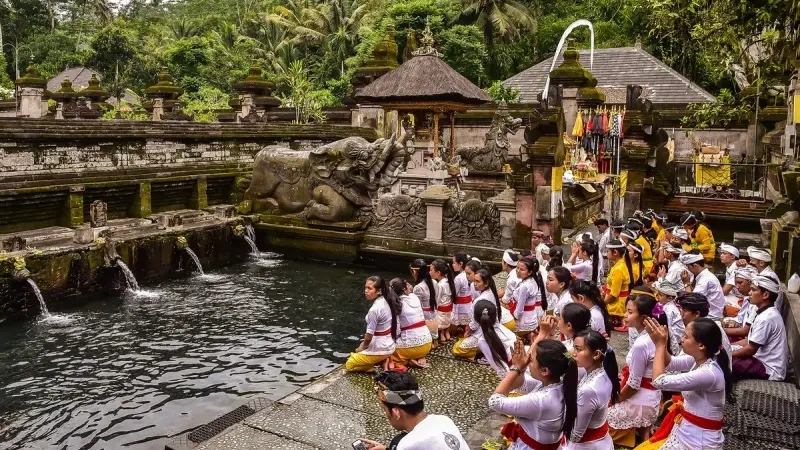Nestled in the heart of Bali, Indonesia, lies Pura Tirta Empul, a Hindu Balinese water temple revered for its holy springs and spiritual significance.
Situated near the town of Tampaksiring, this temple is a cornerstone of Balinese culture and religion, attracting pilgrims and tourists alike.
Pura Tirta Empul, with its sacred water pools and serene ambiance, offers a unique glimpse into the spiritual practices of Bali.
The History of Pura Tirta Empul
The origins of Pura Tirta Empul date back to the 10th century, making it one of Bali’s oldest and most significant temples.
The temple was built around a natural spring, which is believed to have been created by the Hindu god Indra and possesses curative properties. It has been a place of Hindu pilgrimage for over a thousand years, serving as a site for spiritual purification and ritual bathing.
The Sacred Springs and Ritual Baths
The heart of Pura Tirta Empul is its rectangular bathing pool, fed by the holy spring through twelve fountains.
Pilgrims and visitors partake in a purification ritual known as ‘melukat,’ immersing themselves in the pool and moving from fountain to fountain. This ritual is believed to cleanse the soul and body and bring about healing and spiritual merit.
Architectural Beauty and Religious Significance
The temple complex comprises a series of courtyards and shrines, each adorned with traditional Balinese architecture and intricate stone carvings.
The temple’s layout follows a typical Balinese design, with a split gate entrance (candi bentar), central courtyard (jaba tengah), and inner sanctum (jeroan).
The Inner Sanctum and Shrines
The inner sanctum of Pura Tirta Empul houses various shrines dedicated to Hindu deities, including Shiva, Vishnu, and Brahma, as well as the Balinese god of fertility. The tranquility and spiritual ambiance of the inner sanctum provide a space for prayer and meditation.
The Tirta Empul Legend
According to Balinese legend, the sacred spring was created by the god Indra to revive his forces, poisoned by the demon king Mayadanawa. This mythological tale is commemorated in a temple festival known as ‘Piodalan,’ held every 210 days according to the Balinese Pawukon calendar.
Cultural and Ecological Preservation
Pura Tirta Empul is not only a spiritual center but also a site for cultural and ecological preservation. The temple plays a significant role in maintaining the traditional Balinese Hindu practices and preserving the natural environment surrounding the holy spring.
Visiting Pura Tirta Empul
Visitors to Pura Tirta Empul are advised to dress respectfully, covering shoulders and legs. Sarongs and sashes are available for rent at the temple. Respect for the religious customs and the sanctity of the spring is expected from all visitors, whether participating in the purification ritual or observing.
The Surrounding Area
The area around Pura Tirta Empul is rich in cultural and natural attractions, including the presidential palace Istana Tampaksiring, the Gunung Kawi Temple, and scenic rice terraces. The region’s lush landscapes and tranquil atmosphere complement the spiritual experience of visiting the temple.
Conclusion
Pura Tirta Empul is more than just a tourist destination; it is a living symbol of Bali’s religious traditions and cultural heritage. The temple, with its holy waters and peaceful surroundings, offers a unique experience of spiritual renewal and cultural immersion.
A visit to Pura Tirta Empul is a journey into the heart of Balinese spirituality, where the sacred waters continue to flow with historical and religious significance.
